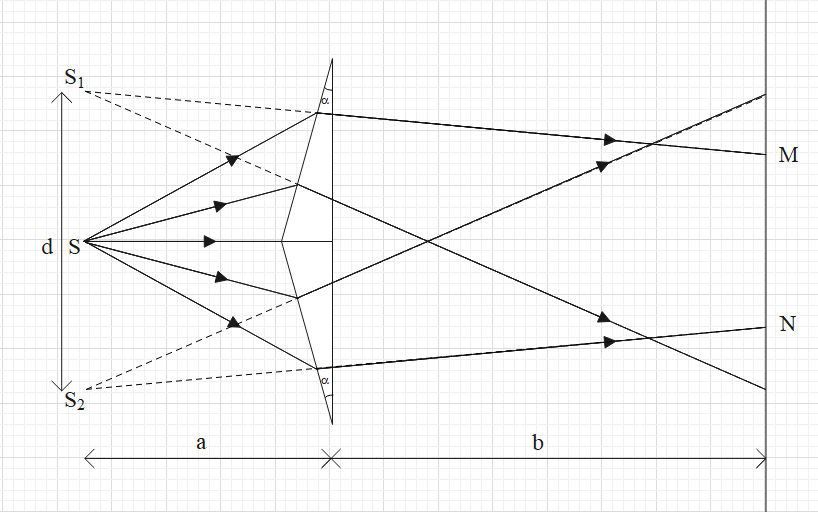
Describe biprism experiment to find the wavelength of monochromatic light. Draw the necessary ray diagram from magnified and diminished images of virtual sources.
Answer
582.9k+ views
Hint: In Fresnel’s biprism experiment, the two coherent sources that are required for the interference pattern are produced with the help of two thin prisms. To find the wavelength of the light use the formula $\beta =\dfrac{\lambda D}{d}$
Formula used:
$\beta =\dfrac{\lambda D}{d}$
Complete step-by-step solution -
Fresnel’s biprism experiment is similar to young’s double slit experiment. In Fresnel’s biprism experiment a biprism is used to make the two coherent sources of light. Then the waves from these two virtual sources interfere on the screen to give a pattern of bright and dark fringes.
The biprism is made by joining two identical thin prisms base to base (as shown in the figure below). The angles of prisms are very small. The acute angle of the prism is about half degree and the obtuse angle is about 179 degrees.

When a monochromatic light source is placed in front of the biprism, two virtual coherent light sources are formed (as shown in the figure). As we can see in the figure that the interference takes place between M and N.
From YDSE we know that fringe width is equal to $\beta =\dfrac{\lambda D}{d}$.
where, $\lambda $ is the wavelength of the monochromatic light, D is the distance between the light sources and the screen and d is the distance between the two sources of light .
In this experiment, the distance between the light sources and the screen is equal to D=(a+b).
If the angle of the prism is $\alpha $ and the refractive index is $\mu $ then $d=2a(\mu -1)\alpha $.
Therefore, this gives us that
$\beta =\dfrac{\lambda (a+b)}{2a(\mu -1)\alpha }$
$\Rightarrow \lambda =\dfrac{2a(\mu -1)\alpha \beta }{(a+b)}$.
The value of the fringe width is found with the help of a microscope.
Hence, the wavelength of the light can be calculated.
Note: The Fresnel’s biprism experiment and the Young’s double slit experiment are similar. The purpose of both the experiments is to obtain an interference pattern on the screen but the methods involved are different.
In YDSE, the two coherent light sources are produced by passing a light through two small slits. This works on the principle of Huygens’ theory of waves.
The two sources of light that interference must be coherent. Otherwise, we will not get the required pattern.
Formula used:
$\beta =\dfrac{\lambda D}{d}$
Complete step-by-step solution -
Fresnel’s biprism experiment is similar to young’s double slit experiment. In Fresnel’s biprism experiment a biprism is used to make the two coherent sources of light. Then the waves from these two virtual sources interfere on the screen to give a pattern of bright and dark fringes.
The biprism is made by joining two identical thin prisms base to base (as shown in the figure below). The angles of prisms are very small. The acute angle of the prism is about half degree and the obtuse angle is about 179 degrees.

When a monochromatic light source is placed in front of the biprism, two virtual coherent light sources are formed (as shown in the figure). As we can see in the figure that the interference takes place between M and N.
From YDSE we know that fringe width is equal to $\beta =\dfrac{\lambda D}{d}$.
where, $\lambda $ is the wavelength of the monochromatic light, D is the distance between the light sources and the screen and d is the distance between the two sources of light .
In this experiment, the distance between the light sources and the screen is equal to D=(a+b).
If the angle of the prism is $\alpha $ and the refractive index is $\mu $ then $d=2a(\mu -1)\alpha $.
Therefore, this gives us that
$\beta =\dfrac{\lambda (a+b)}{2a(\mu -1)\alpha }$
$\Rightarrow \lambda =\dfrac{2a(\mu -1)\alpha \beta }{(a+b)}$.
The value of the fringe width is found with the help of a microscope.
Hence, the wavelength of the light can be calculated.
Note: The Fresnel’s biprism experiment and the Young’s double slit experiment are similar. The purpose of both the experiments is to obtain an interference pattern on the screen but the methods involved are different.
In YDSE, the two coherent light sources are produced by passing a light through two small slits. This works on the principle of Huygens’ theory of waves.
The two sources of light that interference must be coherent. Otherwise, we will not get the required pattern.
Recently Updated Pages
Calculate the ratio of electric to gravitational force class 12 physics CBSE

Explain Groves process class 12 chemistry CBSE

Calculate the potential difference and the energy stored class 12 physics CBSE

How can tree planting prevent soil erosion class 12 biology CBSE

Amniocentesis is a technique used to A Determine errors class 12 biology CBSE

To determine refractive index of glass slab using a class 12 physics CBSE

Trending doubts
What are the major means of transport Explain each class 12 social science CBSE

Which are the Top 10 Largest Countries of the World?

Draw a labelled sketch of the human eye class 12 physics CBSE

How much time does it take to bleed after eating p class 12 biology CBSE

Explain sex determination in humans with line diag class 12 biology CBSE

When was the first election held in India a 194748 class 12 sst CBSE




